 GOVERNMENT OF INDIA
GOVERNMENT OF INDIA- A Digital India Initiative
Your session is about to expire. Do you want to regenerate it?
Please login using your email address as it is mandatory to access all the services of event.data.gov.in
 GOVERNMENT OF INDIA
GOVERNMENT OF INDIA
12/Aug/2024 12:00 pm
12/Oct/2024 12:00 pm
Online
Online, Delhi, Delhi,
India
Registration Closed

The purpose of this Hackathon is to engage Indian students, researchers, and innovators in developing advanced, data-driven AI and ML solutions based on given data set. Participants will have access to a comprehensive data set containing approximately 900,000 records, each with around 21 attributes and target variables. This data is anonymized, meticulously labeled, and includes training, testing, and a non-validated subset reserved specifically for final evaluations by the GSTN.
Participants are encouraged to use this dataset to design and implement innovative artificial intelligence (AI) and machine learning (ML) algorithms to tackle the stated challenge.
Additionally, this initiative aims to foster collaboration between academia and industry professionals, driving the development of effective and insightful solutions that strengthen the GST analytics framework.
PARTICIPATION
Indian students or researchers associated with educational institutions, or working professionals associated with Indian startups and companies can participate in the Hackathon. The participant must be the citizen of India.
LOGIN AND REGISTRATION
All participants must register at Janparichay. A registered user can directly login at https://event.data.gov.in and submit required details to participate in the Hackathon. It is expected that the participants would submit accurate and up-to-date details and they have to confirm this before submission.
Steps for Login and Registration:
STRUCTURE OF THE HACKATHON
Given a dataset D, which consists of:
Dtrain A matrix of dimension R(m×n) representing the training data.
Dtest A matrix of dimension R(m1×n) representing the test data.
We have also provided corresponding target variable Ytrain matrix dimension of R(m×1) and
Ytest with matrix dimension of R(m1×1).
The objective is to construct a predictive model Fθ(X)→ Ypred that accurately estimates the target variable Y{i} for new, unseen inputs X{i}
Steps:
Define a predictive function Fθ(X) parameterized by θ that maps input features X to predicted outputs Ypred.
The model Fθ(X) should be designed to capture the relationship between the input features and the target variable effectively.
2. Training:
Optimize the model parameters θ by minimizing a loss function L(Y,Fθ(X)) using the training data Dtrain
Consider incorporating feature transformations, feature engineering, or feature selection to enhance the model’s predictive performance.
3. Testing:
Apply the learned model Fθ *(X) (with optimized parameters 𝜃∗) to the test data Dtest to generate predictions Ypred for each input Xj∈{X1,X2,…,Xm1}.
4. Performance Optimization:
Evaluate the model’s performance by calculating accuracy or other relevant metrics M on the test predictions Ypred_test.
Refine the model by iteratively adjusting θ or modifying Fθ(X) to improve performance on the chosen evaluation metrics M.
5. Submission:
Present the predicted outputs Ypred_test along with a detailed report that includes:
** Kindly refer ‘Submission and Expectation’ page before submitting your solutions.
TECH STACK FOR BUILDING AI/ML BASED ALGORITHM
PRIZES
The Hackathon offers significant prizes for the top-performing teams, and these are:
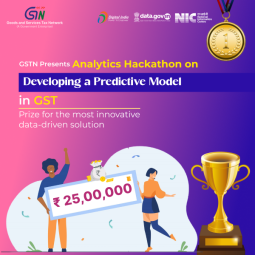
FIRST PRIZE

SECOND PRIZE
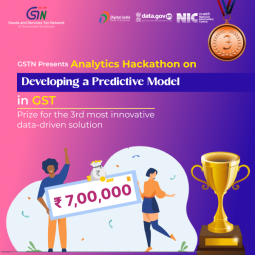
THIRD PRIZE

SPECIAL PRIZE
CONSOLATION PRIZES
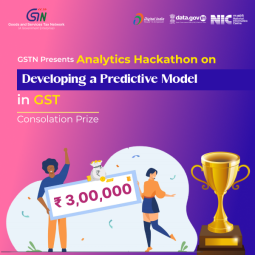

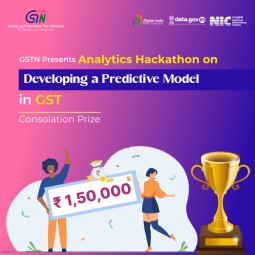
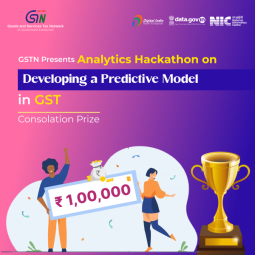
* Note that the prizes declared are for selection after the second round and not the initial stage.
TERMS AND CONDITIONS FOR GST ANALYTICS HACKATHON
These terms and conditions govern the Online Hackathon on GST Analytics Hackathon. By registering and participating in the event, one is deemed to have accepted terms and conditions mentioned below as well as the terms of use of the OGD Platform India.
GENERAL TERMS AND CONDITIONS
Please read these Terms and Conditions carefully as they apply for the Hackathon. To be eligible to participate and declared as shortlisted or winners in the Hackathon, the participants must abide by these Terms and Conditions:
NON-DISCLOSURE AGREEMENT
Notwithstanding whether such Confidential Information is received before or after the date of this Agreement.
SUBMISSION & EVALUATION OF MODEL AND ITS IMPACT
EXPECTED DELIVERABLES FROM PARTICIPANTS
SUBMIT PROJECT
Note – ZIP in GitHub should have the same checksum as submitted in the submission form. Participant provided checksum should match with the checksum generated at the time of evaluation. Mismatch in these may lead to disqualification.
PLAGIARISM AND ETHICS
The evaluation process of the Hackathon would be overseen by a distinguished panel of jury members comprising experts from the fields of machine learning, data science, and tax administration. The jury would rigorously assess each submission based on predefined criteria to ensure a fair and comprehensive evaluation.
JURY COMPOSITION: The jury would tentatively include:
Jury list would be published shortly.
EVALUATION PROCESS
DECISION MAKING
What is the purpose of this Hackathon?
The goal of this Hackathon is to engage participants in developing an innovative predictive supervised model. Specifically, participants would create a mapping function, denoted as y = f(x), using a dataset that includes attributes x1, x2, x3, x4,…, xn. The target variable indicates whether a specific entity has been historically identified as a “0” or “1”. This challenge invites participants to explore the intricacies of predictive modelling and feature engineering to develop insightful solutions.
Who can participate in the Hackathon?
Indian students or researchers associated with educational institutions, or working professionals associated with Indian startups and companies can participate in the Hackathon. The participant must be the citizen of India.
Can participants form teams?
Yes, the participants are expected to form teams of up to five members including at least one team lead.
Can a participant be part of multiple teams?
No, a participant may only register as a member of a single team.
Are employees of the GSTN and NIC eligible to Participate?
No, the employees of GSTN, NIC and Vendors associated with GSTN may not participate in the Hackathon.
How can one register for the Hackathon?
Please visit the official event page on the OGD Event website.
Are participants required to register on any specific platform?
Yes, all participants must register on Janparichay or OGD Platform.
What are the problem statements for the Hackathon?
The detailed problem statement is available on the official event page. The primary challenge involves developing a predictive model in the GST system using the provided dataset.
How would the Hackathon be organised? Would it require in-person participation?
The Hackathon would be organised as an online event with processes for registration of participants, accessing the datasets to be utilized for each problem statement, and submission of developed prototypes. There would be an offline event with the shortlist participants for the finale/second round.
What is the timeline for the Hackathon?
The Hackathon would take place over 45 days from the start of registration to the final date for submission of developed prototypes.
What data would be provided to participants?
Participants would receive a dataset containing 9 lakh records with around 21 attributes each. The data is anonymized and labelled, including trained, validated, and non-validated datasets.
What needs to be submitted for evaluation?
Participants must submit developed prototypes based on the provided problem statement. Detailed submission requirements can be found on the official event page.
Would there be any jury for evaluation?
Yes, a jury comprising experts from various relevant fields would evaluate the prototypes submitted in response to the problem statement.
What are the rewards for selected entries?
What are the evaluation criteria?
The jury would evaluate the submitted prototypes based on the following criteria:
Are there any guidelines for technology usage?
Yes, participants may only submit original materials under an Open-Source license, including third-party components that are available under Open-Source licenses.
Can participants use any technology?
Participants are encouraged to implement the latest emerging technologies like AI, ML, etc.
What happens if a participant provides false information?
A participant providing false information during the registration process or later in the Hackathon would be disqualified.
Must participants keep their contact information updated?
Yes, it is mandatory for participants to provide correct contact information and update it as necessary.
Can participants have multiple accounts on the submission platforms?
No, each participant/team may create only a single account. Similarly, a team may create only a single account.
Is originality of the application important?
Yes, participants must certify the originality of their work before submitting it for evaluation.
Can participants submit previously published or awarded work?
No, the submitted prototypes must be originally produced for this Hackathon.
What if a participant is employed and participating?
It would be considered that by successfully registering, you certify that, as a working professional, you have your employer’s consent and have ensured that there is no violation of your employer’s policies.
Are there any restrictions on the code submitted?
The code submitted must be free from malware, including adware, ransomware, spyware, viruses, worms, etc.
Are there any specific guidelines to follow when completing the text fields in the project submission form to prevent technical issues?
Please adhere to the following instructions while submitting Project submission form :
What legal terms must participants follow?
Participants must follow the Terms and Conditions of the Hackathon. By successfully registering on the portal, it is considered that you agree to the terms and conditions, including the Non-Disclosure Agreement (Annexure-A), as stated in the terms and conditions and FAQ section.
How long must the awarded prototypes be maintained?
Awarded prototypes would be the property of GSTN and would be free to use as it deemed fit.
What is the jury’s role in decision making?
The jury would have the final decision regarding the awarding of the most innovative and promising prototypes, which cannot be challenged.
Can the terms and conditions of the Hackathon change?
Yes, the terms and conditions may be changed by the GSTN as needed.
What if traveling is required for the finale/second round?
In case traveling is required for the finale round to Delhi, the travel cost of Second AC or Economy Class in flight would be borne by GSTN. Additionally, lodging and food for the intended period of stay would be provided by GSTN.
What happens to the submitted models?
All models submitted or awarded in the finale of the GST Analytics Hackathon would become the property of GSTN. GSTN reserves the right to use these models as deemed appropriate. Additionally, any model submitted/awarded, upon the discretion of GSTN, shall be governed by a Non-Disclosure Agreement (NDA) to ensure confidentiality and appropriate use of the developed solutions.
Who is encouraged to participate?
Participants, especially those from academic and research institutions who are dealing with data modelling, are particularly encouraged to participate. This initiative aims to harness the innovative potential of students and researchers to develop cutting-edge solutions for the GST system.
What happens to the intellectual property of the submitted solutions?
The models submitted or awarded would become the property of GSTN, including all intellectual property rights to their underlying methodologies and innovations, and the participants shall be deemed to have given their no objection/consent for the same and shall also remain bound by the terms of Non-Disclosure Agreement (NDA) with respect to such work. The participants agree to provide a No Objection Certificate as an author in favour of GSTN for the purposes of IPR registration and ownership rights, as and when required by GSTN.
Is there any technical support available during the Hackathon?
Yes, technical support (related submission only) would be available throughout the Hackathon. Participants can write to ndsap@gov.in for any query.
Can I upload multiple solutions until the final date?
Yes, team can upload multiple solutions until the final date. In this case, the last entry you submit would be considered for evaluation.
What is the timeline for evaluation and announcement of winners?
The evaluation of submitted prototypes would take place immediately after the submission deadline. Winners would be announced within two weeks of the final submission date.
Is there a code of conduct for participants?
Yes, all participants are expected to adhere to a code of conduct that promotes respect, fairness, and integrity. Any violations may result in disqualification.
Would there be opportunities for continued engagement after the Hackathon?
Yes, GSTN may offer continued support and engagement opportunities for participants to further develop and implement their solutions. Details would be shared with the relevant team’s post-hackathon.
